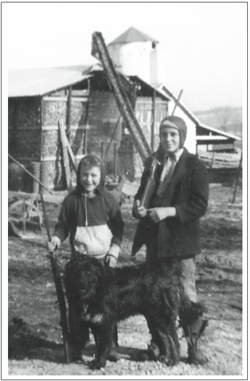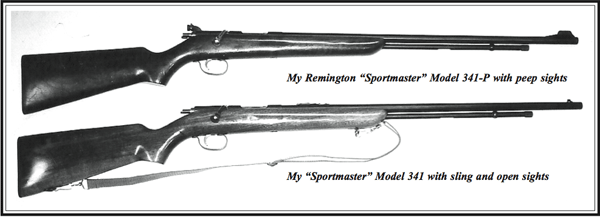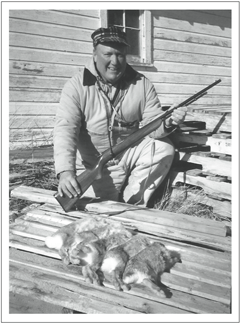
|
My dad, Don Boddicker, graduated from the University of Iowa Law School in 1937. He set up his law practice in Vinton, Iowa, the county seat, and proceeded to try to make a living as The Great Depression wound down. But business was not great for a new lawyer in 1937. He spent a lot of time doing his civic duties, including being a Scout Master for Boy Scouts, helping to organize a church, and eventually running for county attorney and winning as a Republican. He signed up for the U.S. Army in September 1941 (just three months before Pearl Harbor), joining the Adjutant General Corp. He said he knew that war was coming, and he wanted to get in early so he could get an assignment where he wouldn’t get killed. Dad spent 18 months in France as the Commanding Officer of a prisoner-of-war compound for Germans, outside of Paris, France. When he moved to Vinton in 1937, he brought along a 12 gauge Excel single- barrel shotgun from home. Shortly after that, he bought a Remington Model 341-P Sportmaster .22 bolt action rifle, serial # 111319. I don’t think it was new, because it had the original peep sight replaced with an open site. Dad came back from WWII as a Truman Democrat. He occasionally declared that a 12 gauge shotgun and a .22 rifle were all the guns a man ever needed. Dad and I never agreed on much from the time I was a little kid. Dad moved us to a farm west of Vinton when I was seven, with mom yelling all the way. Mom said I was born with a gun in my hand, and the first thing I remember doing was hunting a honey bee and catching it. Yea, it stung me good. I went crying to Mom, at age three |
When I was five, I got a Daisy BB gun, single shot, for my birthday and wore it out in a year and a half. By age seven, I had moved up to the powerful Daisy pump BB gun and was regularly bringing home pigeons and an occasional quail for the pot. I remember on a very cold and snowy day in 1950, my uncle Cato, my dad and I were working cattle in our small farm feedlot. I spotted a cottontail sitting between the blades of a disk. Uncle Cato told me to get the .22 and some shells, and he would let me shoot it. That was my first rabbit, and my first chance to shoot the Sportmaster. Rabbits were big game in Iowa in the early ’50s, and I was eight. After that, I begged dad and mom to let me hunt with the Model 341. BB guns just didn’t do it for me anymore. So for Christmas that year (1950), Dad bought me a brick of Remington .22 shorts, took the magazine tube out of the Sportmaster and gave me permission to shoot it, but only as a single shot. Further, he made a deal he said he always regretted: In exchange for cleaning all the game that I shot, he shot, and his fiends shot, he would buy all of the ammo I wanted to shoot as long as I shot at least two edible critters per box of 50 shells. Whoa! We ate a lot of pigeons, rabbits, squirrels, an occasional quail and often pheasants that I had popped with the Sportmaster. He put his foot down at eating ground squirrels, blackbirds, and starlings on the deal. I shot up an average of 500 rounds a month. By age eleven I was so good with the little rifle that I would tag along with dad and his WWII buddies, pheasant |
| Page 34 | 1st Quarter 2011 |
|
hunting. After they would miss with their expensive shotguns, I would knock the pheas- ant out of the sky with my Remington Sportmaster and a .22 short cartridge! Don, gall dang it! Doc Genesse exclaimed. Buy this kid a shotgun for Christmas so next year he can miss like the rest of us. So, I got my first shotgun , a .410 Stevens single shot. Then they really had some competition. Dad made me bird dog and ordered me to only shoot rabbits when we hunted with his friends. It was all in fun. I literally shot my Sportmaster every day. It traveled hundreds of miles with me on our tractors just in case a bunny or pheasant showed up. |
My Sportmaster shot a lot of firsts for me:
|
The Model 341-P sold for around $15oo when introduced, which was a month’s wages for a rural farm worker, if he could find work. When you pick up a Model 341, it is a classy piece of work, with the steel, strength, a streamlined fit, a crisp positive |
|
The rifle was faithfully cleaned once a week or whenever it got wet from rain or snow. I will never forget cleaning it on cold winter nights, sitting behind the old kerosene stove on a bench in the kitchen – the only warm place in the house. Out of the window at my back, I would watch the snow whirl in the barnyard under a dim yard light. Hoppes #9 and Singer Sewing Machine Oil were applied to each part with a brass brush, an old tooth brush, and an old flannel shirt patch, with loving care. Great memories! According to Roy Marcot’s Remington, American’s Oldest Gun Maker, Remington brought out the Sportmaster Model 341 in February 1936. There were five varieties of the rifle based on the furnished sights or whether or not it was drilled and tapped for scope mounts. Remington 341 rifles succeeded the Model 34, the brainchild of Crawford C. Loomis. The Models 33, 34, and 341 were Remington’s entry into the boys’ rifle competition going on during the Depression between the hard-strapped gun companies. |

| I shot an average of 500 rounds a month through my beloved Sportmaster – about 48,000 rounds! When I was 12, Dad sold the rifle to me for $12.50, which I paid off from my pocket gopher trapping money in monthly installments. I also got the maga- zine tube with the purchase, and thereafter single-shot loading was over. Dad broke the safety off the next year by throwing a fence post onitasitlayina wagon box. |
| Page 35 | 1st Quarter 2011 |

|
By 1958, all of the .22 shorts, grime and grit, cleaning, wear and sundry other problems caused the empty cases to stick in the well-worn chamber. The extractor would ride up over the rim, and the case had to be pried out with a knife or screw driver, which I did for a year or so. Then in frustration, I bought another rifle, a Winchester pump. I never liked it and sold it to a friend to get money to buy a wedding ring in 1963. The Model 341, I gave to my younger brother, Tim. He, with my other brother, Tom, were shooting the old Sportmaster yet in 1962. Sometime that year Tim took it to school to try to fix the bolt so it would extract, and he damaged the bolt beyond repair. The Sportmaster sat in the closet at home until 1994 when Tim passed away from a heart attack. I inherited the gun, but it |
and Accraglassed the stock, which turned out great. My old Sportmaster friend was looking good. I took it to the range and fired eight different types of .22 ammo through it. The average groups at 35 yards were 1.06″. The best ammo was Ely Standard, which shot a .75″ group. The four Model 341s I have owned have averaged groups of 1.1″ at 3 5 yards. On Christmas morning 2001, I gave it to my oldest grandson, Joel, age 12. Two weeks later he killed a coyote with it that Grandpa Maj called up and Uncle Jim had slowed down. It was fun to see the old Sportmaster back in action. Joel has shot some prairie dogs and sundry sparrows with it, but living in town, he doesn’t shoot it as often as I did, so the gun doesn’t see the kind of action it had in the old days of his granddad’s youth. |
|
stock cut off, a hand-made lead butt plate, and the bolt was ruined and the safety was broken off. It had a bulge in the barrel about 3-inches from the muzzle. The receiver, trigger, feeding mechanism, magazine tube, and sights were okay, so I set about to resurrect my old friend. A new Model 34 barrel turned up in Pennsylvania, which I found on Gun List magazine. It fit fine. I bought a trashed- out Model 341 at a local gun shop that had a good bolt and repairable stock. A gunsmith friend exchanged barrels and sights. I refinished |
 The author with a nice Sportmaster and five cottontails shot on a Wyoming hunt. |
Model 341-P Sportmasters show up at gun shows, auctions, and used gun shops on occasion, selling from $35oo to $250oo, depending on the condition and the owner’s knowledge of current prices. In good shape, they are an excellent bargain. I have owned maybe fifteen Model 34s and 341 s. All but two of them shot excellent groups equivalent to the average grades of .22s sold today. When they don’t shoot, generally there is an obvious reason like a bulged barrel. Don’t throw it away. They can be sleeved with a new .22 kit from Brownells. |
| Page 36 | 1st Quarter 2011 |
|
Or, sleeve it with the new .17 Mach II Hornady. Cost is about $120oo. You have to shoot the sharp pointed ammo with one in the magazine and handload one in the chamber. The sharp points slide off to the side of the cartridge in front of it which jams up the magazine. I think hollow points or more rounded point Mach II ammo will work just fine through the magazine, when it becomes available. Sportmasters hold 15 rounds of.22 long rifle ammo, which makes it great for prairie dog and ground squirrel shooting. Of course, it is a terrific cottontail and fox squirrel hunting rifle. Like most old Remington guns, many Model 341 Sportmasters have been “rode hard and put away wet,†so it takes some tender loving care to get them back in top shape. The really beat-up ones are too far gone to be collectors anyway, so they appreciate being refurbished and put back to hunting. I gave my grandson, Patrick, a Model 34l-P in great shape for Christmas this year. I also gave my nephew , Joey, a Model 34 and my grandson, Zane, a Model 512- X. They are some happy kids. We tried these great old Remington .22s out on a cottontail hunt right after Christmas. They shoot as good now as they did 67+ years ago. |
Several weeks ago, I got into a bunch of cottontails in a bunny honey hole in eastern Wyoming. Two friends and I picked off our limits of 30 cottontails in less than an hour. It took longer to clean them than it did to shoot them. The Sportmaster was the perfect rifle for that job. The open sights are fairly fine, so shooting rabbit heads at 30 to 50 yards is no big challenge. The rifle weighs six pounds, carries easily, and swings and lines up fast on running bunnies. I am not the shot I used to be with it, but good enough to fill the larder up with young fat rabbits. Whether you are a collector or a small game hunter, or both, the Remington Sportmaster Model 341 is a great classic to have. Major Boddicker |
Remington Model 341 Sportmaster Bolt Action Repeating Rifles Remington’s popular Model 34 bolt action, .22 Caliber repeating rifle, introduced in 1932, was one of the first products re-evaluated in May 1935 by Crawford C. Loomis. The result was the Model 341 Sportmaster Rifle, introduced in February 1936. In the months to come the following variations were made available:
The Model 341 was discontinued in late October 1940, scarcely four months after it was introduced. There were runoff sales through 1941, and in all, 131,604 M341 Sportmaster Rifles were sold. The M341 Sportmaster was replaced in 1940 by the Remington Model 512 Sportmaster rifle. |
| Page 37 | 1st Quarter 2011 |
|
On-line Search/Sort Journal Index How can I submit an article for a future issue? How can I purchase back issues of the RSA Journal? |
On-line Journal Articles New Journals have links to
|
